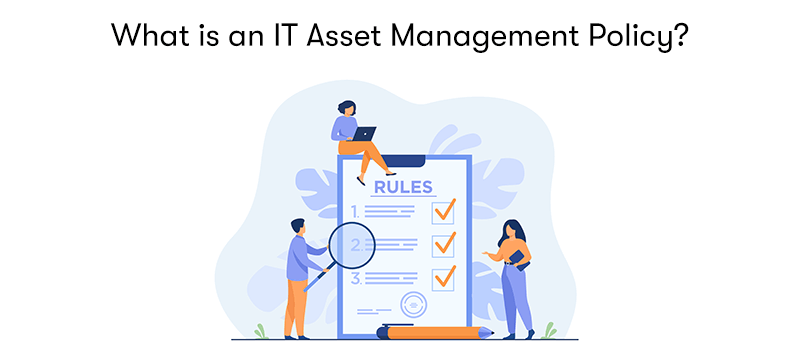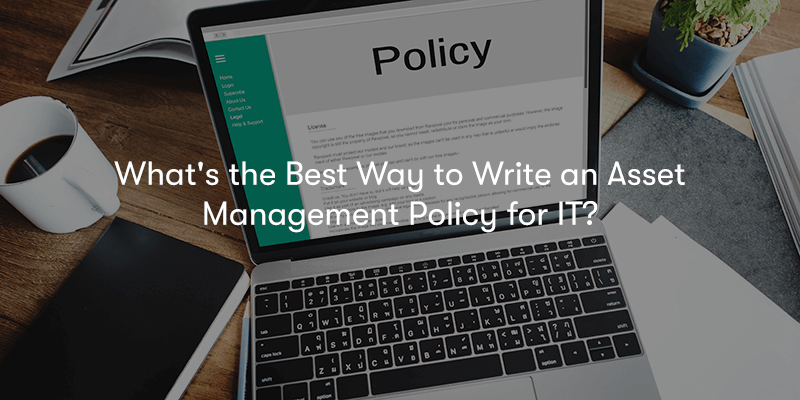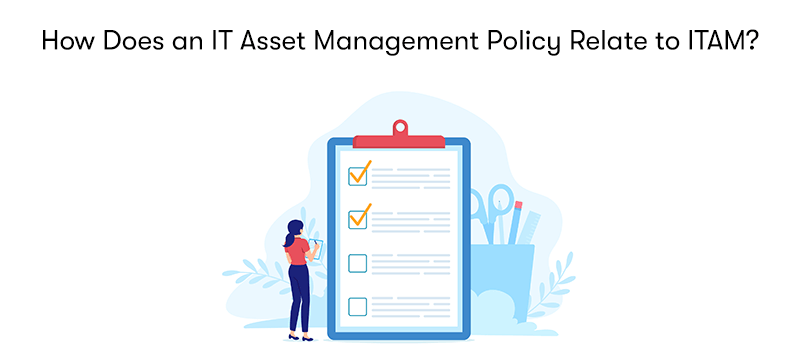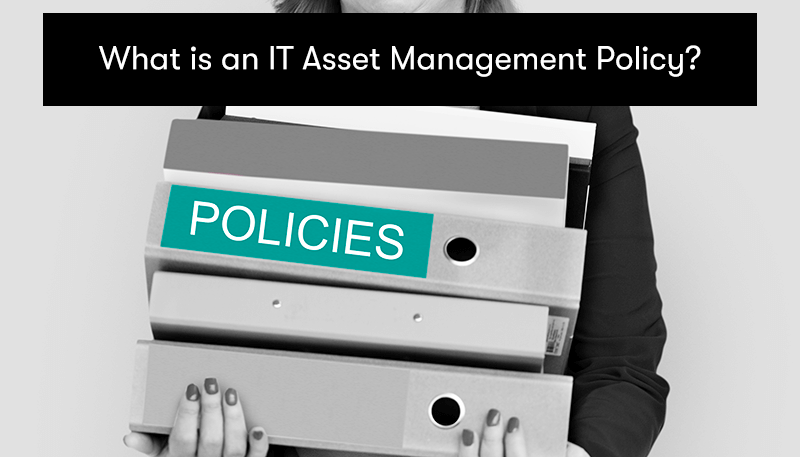What is an IT Asset Management Policy?
Welcome to our in-depth exploration of IT Asset Management (ITAM) policies, a cornerstone of modern organisational infrastructure. In today's rapidly evolving technological landscape, the effective management of IT assets is more crucial than ever.
An ITAM policy is not merely a set of guidelines; it's a strategic blueprint that governs how an organisation acquires, utilises, maintains, and retires its IT assets. These policies are pivotal in optimising resource allocation, controlling costs, and mitigating risks.
In this blog, we will delve into what an ITAM policy entails, its key components, and why it is an indispensable tool for businesses seeking to harness the full potential of their IT investments while aligning with compliance standards and operational objectives. Join us as we unravel the essentials of IT Asset Management policies.
What is an IT Asset Management Policy?

An IT Asset Management Policy is a set of guidelines and procedures for effectively managing an organisation's information technology assets throughout its life cycle. This policy typically covers various aspects of IT asset management, including:
Asset Identification: This involves cataloguing and tracking all IT assets, including hardware, software, and networking equipment. Assets are usually tagged and recorded in a central database.
Procurement and Acquisition: The policy outlines procedures for acquiring IT assets, including approval processes, vendor selection, and purchase methods.
Deployment and Usage: Guidelines for deploying IT assets within the organisation, including installation, configuration, and assignment to users or departments.
Maintenance and Upgrades: Procedures for regular maintenance, updates, and upgrades of IT assets to ensure they remain functional, secure, and efficient.
Risk Management and Compliance: Addressing the risks associated with IT assets, including security risks, and ensuring compliance with relevant laws, regulations, and organisational policies.
Asset Disposal: Procedures for the secure and environmentally responsible disposal or recycling of IT assets when they are no longer needed or have reached the end of their useful life.
Performance Monitoring: Regularly assess IT assets to ensure they meet performance standards and contribute effectively to the organisation's goals.
Financial Management: Managing the financial aspects of IT assets, including budgeting, cost analysis, and return on investment.
Documentation and Reporting: Keeping detailed records of all IT assets and their management processes and generating reports for analysis and decision-making.
Responsibility and Accountability: Assigning responsibilities for various aspects of IT asset management to specific roles or departments within the organisation.
An effective ITAM policy helps organisations optimise the use of IT assets, reduce costs, enhance productivity, and ensure compliance with regulatory and corporate standards.
Why Are IT Asset Management Policies Important for Your Business?
ITAM policies are vital in ensuring financial efficiency, operational effectiveness, compliance, and strategic planning within a business. They are essential in a technology-driven business environment where IT assets form a significant part of organisational infrastructure. Here are some more crucial reasons why ITAM policies are important for your organisation:
Cost Efficiency
ITAM helps in tracking and managing the costs associated with IT assets throughout their lifecycle. This includes acquisition, maintenance, and disposal fees, enabling businesses to make cost-effective decisions and avoid unnecessary expenditures.
Optimised Asset Utilisation
By understanding what assets are available and how they are being used, businesses can maximise the utilisation of existing resources, reducing the need for additional purchases.
Risk Management
Proper asset management reduces risks related to compliance, security, and operational inefficiencies. For instance, it ensures that software licenses are up-to-date and compliant with legal standards and that hardware is not outdated or vulnerable to security breaches.
Strategic Planning
ITAM provides valuable data that can be used for strategic decision-making. It allows businesses to forecast future needs, plan budgets more accurately, and make informed technological investment choices.
Regulatory Compliance
Many industries have regulations regarding data security and privacy. ITAM policies help ensure that the hardware and software used by a business comply with these legal requirements, reducing the risk of legal penalties.
Lifecycle Management
Effective IT asset lifecycle management—from procurement to disposal—ensures that assets are replaced or upgraded appropriately, maintaining operational efficiency and supporting business continuity.
Improved Vendor Management
With a clear overview of all IT assets, businesses can negotiate better terms with vendors, take advantage of warranties and service agreements, and make more informed decisions about vendor relationships.
Enhanced Security
Keeping track of IT assets helps identify unauthorised or unlicensed software and outdated hardware, which could be potential security risks. Regular audits and monitoring help in maintaining a secure IT environment.
Asset Recovery
In case of lost or stolen assets, an ITAM policy aids in asset recovery efforts. It provides accurate records of asset locations and user assignments, which can be crucial in such situations.
Data Integrity and Reporting
Accurate data about IT assets is vital for internal reporting, financial auditing, and making informed decisions. ITAM policies ensure that this data is consistently collected and maintained.
What's the Best Way to Write an Asset Management Policy for IT?

Writing an effective IT Asset Management policy involves several key steps. Here's a guide to help you create a comprehensive policy:
1. Define Objectives and Scope
Start by clearly defining the objectives of the ITAM policy. This should include what you aim to achieve with asset management, such as cost savings, risk reduction, compliance, or operational efficiency. Determine the scope of the policy, specifying which assets (hardware, software, digital assets) it covers.
2. Identify Stakeholders
Recognise who will be affected by the policy and who will be responsible for its implementation. This often includes IT staff, finance departments, and end-users.
3. Develop Asset Lifecycle Framework
Outline the procedures for each stage of an asset's lifecycle:
- Procurement: Guidelines for purchasing, including approval processes and vendor selection.
- Deployment: Procedures for installation, configuration, and assigning assets to users.
- Maintenance and Support: Define how regular maintenance, updates, and technical support will be managed.
- Audit and Reporting: Establish a schedule for inventory audits and reporting requirements.
- Disposition and Disposal: Guidelines for securely and responsibly disposing of assets.
4. Risk Management and Compliance
Include protocols for managing risks, ensuring security, and maintaining compliance with relevant laws and regulations.
5. Roles and Responsibilities
Clearly define the roles and responsibilities of individuals and departments involved in asset management. This should include who is responsible for managing the ITAM policy and who is accountable for individual assets.
6. Documentation and Record-Keeping
Establish guidelines for documenting asset information, including purchase details, licenses, warranties, maintenance records, and disposition data.
7. Performance Monitoring and Review
Include methods for monitoring the performance and effectiveness of IT assets and the ITAM process. Also, set a schedule for regular reviews and updates of the policy.
8. Training and Awareness
Plan for training and awareness programs to ensure that all relevant staff understand the ITAM policy and their respective roles and responsibilities.
9. Budgeting and Financial Management
Provide guidance on budgeting for asset acquisition, maintenance, and disposal. This should align with the organisation's overall financial planning.
10. Policy Review and Continuous Improvement
Include a process for periodic review and updating of the ITAM policy to reflect changing business needs, technological advancements, and regulatory requirements.
11. Approval and Implementation
Once the policy is drafted, key stakeholders should review and approve it. After approval, plan for a structured implementation, including communication of the policy across the organisation.
12. Tools and Resources
Mention any tools or resources that will be used to support the ITAM process, such as asset management software or external consultants.
Remember, an ITAM policy should be clear, concise, and easily understandable. It should be tailored to fit your organisation's specific needs and context. Regularly updating and adapting the policy to new challenges and technologies is key to maintaining effective IT asset management.
What is the Purpose of IT Asset Management Policies?

The purpose of IT Asset Management policies is multi-faceted, serving to streamline and optimise the management of IT resources within an organisation. The key purposes include:
Cost Management and Optimisation
ITAM policies help control and reduce costs associated with IT assets. They enable organisations to avoid unnecessary purchases, negotiate better vendor contracts, and identify cost-saving opportunities by efficiently using existing assets.
Risk Reduction
Proper IT asset management minimises risks related to compliance, security breaches, and operational inefficiencies. Organisations can proactively address potential issues by keeping track of assets, usage, and compliance status.
Regulatory Compliance and Legal Considerations
These policies ensure that all IT assets are in compliance with relevant laws, regulations, and standards. This is particularly important for software licenses, data protection, and privacy laws.
Asset Lifecycle Management
ITAM policies guide the management of assets through their entire lifecycle—from procurement to disposal. This includes maintenance, upgrades, and eventual retirement, ensuring that assets remain efficient and relevant throughout their use.
Resource Optimisation and Efficiency
By tracking and managing IT assets, organisations can ensure optimal allocation and utilisation, preventing resource wastage and ensuring that each asset is used to its full potential.
Supporting Business Objectives
Effective asset management aligns IT resources with business goals and strategies. By understanding the available assets and their capabilities, businesses can make informed decisions supporting their objectives.
Improved Decision-Making
ITAM provides critical data and insights about IT assets, which aids in strategic planning and decision-making. This includes insights into investment needs, performance issues, and opportunities for improvement.
Enhanced Security and Data Integrity
Keeping an accurate inventory of IT assets helps identify and mitigate security risks. It ensures that software is up-to-date and that hardware complies with security standards.
Inventory and Documentation Accuracy
ITAM policies ensure accurate and comprehensive documentation of IT assets, which is essential for audits, financial reporting, and operational transparency.
Disaster Recovery and Business Continuity
Organisations can develop more effective disaster recovery and business continuity plans with a clear understanding of the available IT assets and their criticality.
How Does an IT Asset Management Policy Relate to ITAM?

An IT Asset Management policy is intrinsically linked to an organisation's broader practice of IT Asset Management. The relationship between the two can be understood as follows:
Guiding Framework
The ITAM policy serves as the guiding framework for the ITAM process. It outlines the principles, strategies, and procedures that govern how IT assets are managed throughout their lifecycle. Essentially, the policy provides the foundation upon which the ITAM practices are built.
Standardisation of Processes
The policy standardises the processes and procedures for managing IT assets. This includes procurement, deployment, maintenance, auditing, and disposal. By having a standardised approach, the organisation ensures consistency, efficiency, and control in managing its IT assets.
Risk Management and Compliance
ITAM policy directly addresses risk management and compliance aspects of asset management. It sets forth the rules and guidelines to ensure that IT assets are managed to minimise risks and adhere to regulatory requirements, particularly in software licensing, data security, and privacy.
Defining Roles and Responsibilities
The policy clearly defines the roles and responsibilities of various stakeholders in the ITAM process. This includes IT staff, finance personnel, and end-users. By delineating these roles, the policy ensures accountability and effective management of IT assets.
Performance and Efficiency Metrics
The ITAM policy often includes performance metrics and efficiency goals. These metrics help assess the ITAM process's effectiveness and guide continuous improvement efforts.
Budgeting and Financial Management
The policy provides guidelines for the financial aspects of ITAM, including budgeting for procurement, maintenance, and disposal of IT assets. This helps in making cost-effective decisions and achieving better financial control.
Supporting Business Objectives
The ITAM policy aligns the management of IT assets with the organisation's overall business objectives. It ensures that the IT assets contribute positively to the organisation's goals through cost savings, improved productivity, or other means.
Documentation and Record Keeping
Effective ITAM requires meticulous record-keeping and documentation. The ITAM policy outlines the requirements for documenting asset information, ensuring that accurate and up-to-date records are maintained.
Tools and Resources
The policy may also specify the tools and resources to be used in the ITAM process, such as asset management software, which facilitates the implementation of ITAM practices.
Final Notes on IT Asset Management Policies
In conclusion, our exploration of IT Asset Management policies has underscored their pivotal role in organisations' strategic and efficient management of IT resources. These policies streamline cost management, optimise asset utilisation, significantly reduce operational risks, and ensure regulatory compliance.
By setting a comprehensive framework, ITAM policies standardise procedures across the asset lifecycle, from procurement to disposal, and reinforce accountability through clearly defined roles and responsibilities.
As a linchpin for aligning IT assets with business goals, ITAM policies are indispensable in today's technology-driven landscape. They empower organisations to make informed decisions, maintain financial control, and adapt to the evolving technological environment, ultimately contributing to the overall success and resilience of the business.


